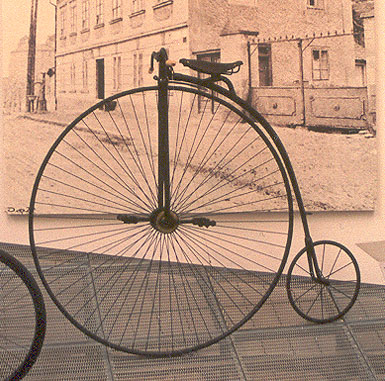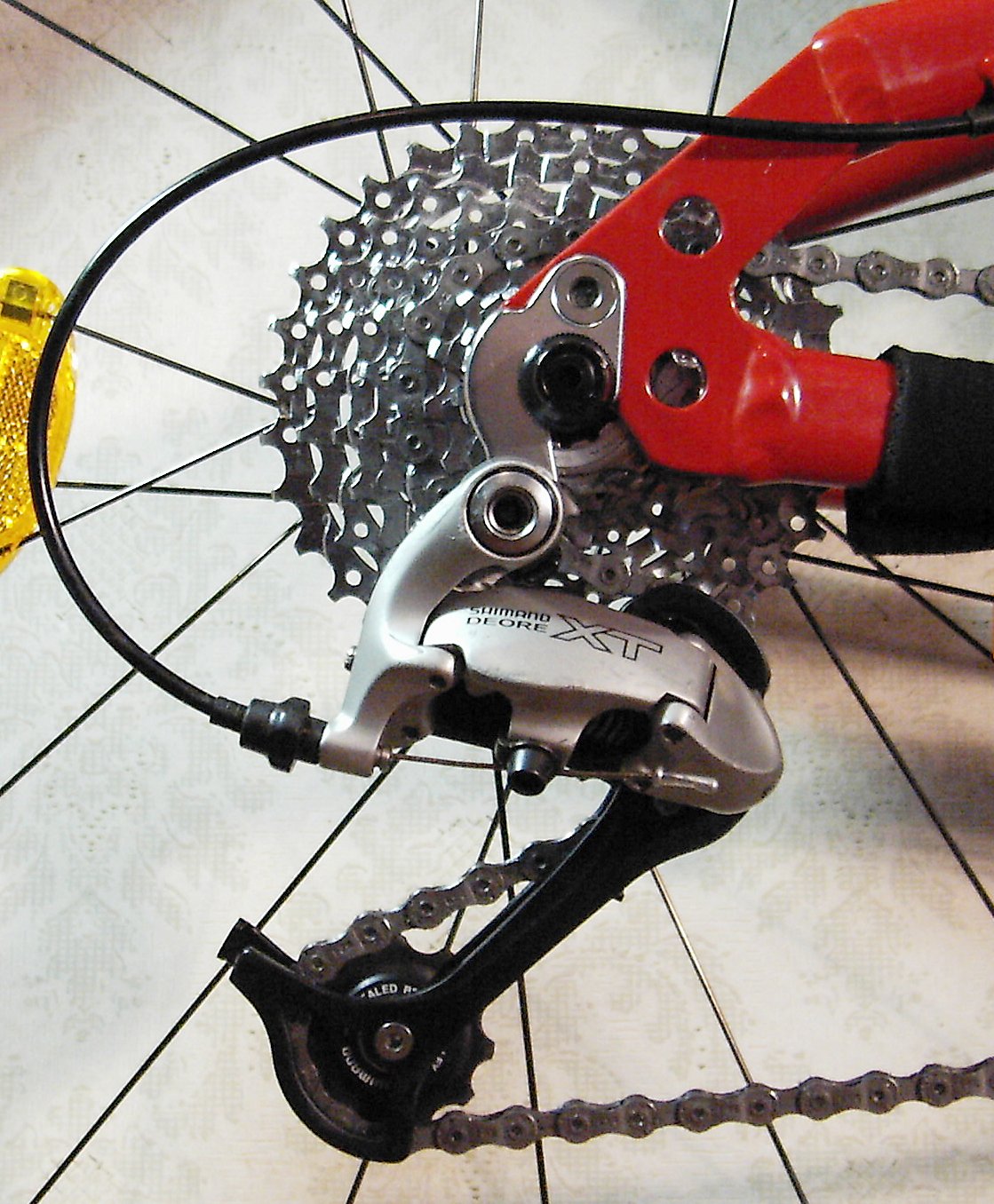|
Chainless Bicycle
A chainless bicycle is a bicycle that transmits power to the driven wheel through a mechanism other than a metal Bicycle chain, chain. Examples * Directly driven "ordinary" bicycle (see penny-farthing) * Shaft-driven bicycle * Belt-driven bicycle * Hydraulic bicycle (and pneumatic bicycle) * Hybrid vehicle#Two-wheeled and cycle-type vehicles, Hybrid vehicle (see series hybrid bicycle) * Some Rowed vehicles#Drive train, rowed bikes use a cable or a linkage. * Stringbike the pulley-driven Hungarian designed bike See also *Bicycle drivetrain systems * Outline of cycling References * External links Cycle types {{Cycling-stub ... [...More Info...] [...Related Items...] OR: [Wikipedia] [Google] [Baidu] |
Bicycle
A bicycle, also called a pedal cycle, bike or cycle, is a human-powered or motor-powered assisted, pedal-driven, single-track vehicle, having two wheels attached to a frame, one behind the other. A is called a cyclist, or bicyclist. Bicycles were introduced in the 19th century in Europe. By the early 21st century, more than 1 billion were in existence. These numbers far exceed the number of cars, both in total and ranked by the number of individual models produced. They are the principal means of transportation in many regions. They also provide a popular form of recreation, and have been adapted for use as children's toys, general fitness, military and police applications, courier services, bicycle racing, and bicycle stunts. The basic shape and configuration of a typical upright or "safety bicycle", has changed little since the first chain-driven model was developed around 1885. However, many details have been improved, especially since the advent of modern ... [...More Info...] [...Related Items...] OR: [Wikipedia] [Google] [Baidu] |
Bicycle Chain
A bicycle chain is a roller chain that transfers power from the pedals to the drive-wheel of a bicycle, thus propelling it. Most bicycle chains are made from plain carbon or alloy steel, but some are nickel-plated to prevent rust, or simply for aesthetics. History Obsolete chain designs previously used on bicycles included the block chain, the skip-link chain, and the Simpson lever chain. The first chains were of a simple, bushing-less design. These had inherent reliability problems and a bit more friction (and mechanical efficiency losses) than modern chains. With these limitations in mind, the Nevoigt brothers, of the German Diamant Bicycle Company, designed the roller chain in 1898, which uses bushings. More recently, the "bushingless roller chain" design has superseded the bushed chain. This design incorporates the bearing surface of the bushing into the inner side plate, with each plate creating half of the bushing. This reduces the number of parts needed to assemble ... [...More Info...] [...Related Items...] OR: [Wikipedia] [Google] [Baidu] |
Penny-farthing
The penny-farthing, also known as a high wheel, high wheeler or ordinary, is an early type of bicycle. It was popular in the 1870s and 1880s, with its large front wheel providing high speeds (owing to its travelling a large distance for every rotation of the legs) and comfort (the large wheel provides greater shock absorption). It became obsolete in the late 1880s with the development of modern bicycles, which provided similar speed amplification via chain-driven gear trains and comfort through pneumatic tires, and were marketed in comparison to penny-farthings as "safety bicycles" because of the reduced danger of falling and the reduced height to fall from. The name came from the British penny and farthing coins, the former being much larger than the latter, so that the side view resembles a larger penny (the front wheel) leading a smaller farthing (the rear wheel). Although the name "penny-farthing" is now the most common, it was probably not used until the machines were ne ... [...More Info...] [...Related Items...] OR: [Wikipedia] [Google] [Baidu] |
Shaft-driven Bicycle
A shaft-driven bicycle is a bicycle that uses a drive shaft instead of a chain to transmit power from the pedals to the wheel. Shaft drives were introduced over a century ago, but were mostly supplanted by chain-driven bicycles due to the gear ranges possible with sprockets and derailleurs. Recently, due to advancements in internal gear technology, a small number of modern shaft-driven bicycles have been introduced. Shaft-driven bikes have a large bevel gear where a conventional bike would have its chain ring. This meshes with another bevel gear mounted on the drive shaft. The use of bevel gears allows the axis of the drive torque from the pedals to be turned through 90 degrees. The drive shaft then has another bevel gear near the rear wheel hub which meshes with a bevel gear on the hub where the rear sprocket would be on a conventional bike, and canceling out the first drive torque change of axis. The 90-degree change of the drive plane that occurs at the bottom bracket and ag ... [...More Info...] [...Related Items...] OR: [Wikipedia] [Google] [Baidu] |
Belt-driven Bicycle
A belt-driven bicycle is a chainless bicycle that uses a toothed synchronous belt to transmit power from the pedals to the wheel. The application of belt drives to bicycles is growing, especially in the commuter bicycle market, due to the low maintenance and lubrication-free benefits. Belt drives are also available for stationary and fitness bicycles. Benefits * Belts do not rust. * Lubrication is not required. ** Cleanliness due to lack of lubrication. ** Little to no maintenance. * Smoother operation. * Quieter than chain. * Longer life than metal bicycle chains. * Some belt systems are lighter than conventional chain-driven system. Drawbacks * Derailleurs cannot be used, so a hub gear is used if multiple gear ratios are required. * Most belts cannot be taken apart as a chain can, so a frame must be able to accommodate the belt by having an opening in the rear triangle or an elevated chain stay. There is only one option where the belt can be spliced and joined th ... [...More Info...] [...Related Items...] OR: [Wikipedia] [Google] [Baidu] |
Hydraulic Bicycle
A hydraulic bicycle is a chainless bicycle that transfers power to the pedals by means of a liquid passing through tubes from hydraulic pump to hydraulic motor and back. Advantages include: * Shifting, through valves and displacement, provides either continuously variable gearing or more steps than traditional bicycles. * Shifts smoothly under full power. * Drive transmits power while pedaling forward and backward. Thus racers can power bicycle through turns by alternating short forward and backward pedal strokes. No slack or backlash occurs, in either direction. Ability to coast is maintained. * Mechanism is clean and operates silently. * Fewer moving parts (about 10 vs over 70), all of which are continuously bathed in clean lubricating fluid. * Sealed systems require less maintenance than open chain system. * Front-wheel drive and two-wheel drive systems can be implemented. (See Two-wheel drive) * Drive can double as a hydraulic brake, eliminating the weight, cost, and maintenanc ... [...More Info...] [...Related Items...] OR: [Wikipedia] [Google] [Baidu] |
Hybrid Vehicle
A hybrid vehicle is one that uses two or more distinct types of power, such as submarines that use diesel when surfaced and batteries when submerged. Other means to store energy include pressurized fluid in hydraulic hybrids. The basic principle with hybrid vehicles is that the different motors work better at different speeds; the electric motor is more efficient at producing torque, or turning power, and the combustion engine is better for maintaining high speed than a typical electric motor. Switching from one to the other at the proper time while speeding up yields a win-win in terms of energy efficiency, such that it translates into greater fuel efficiency. Vehicle types Two-wheeled and cycle-type vehicles Mopeds, electric bicycles, and even electric kick scooters are a simple form of a hybrid, powered by an internal combustion engine or electric motor and the rider's muscles. Early prototype motorcycles in the late 19th century used the same principle. * In a parall ... [...More Info...] [...Related Items...] OR: [Wikipedia] [Google] [Baidu] |
Rowed Vehicles
A rowing cycle is a wheeled vehicle propelled by a rowing motion of the body. Steering, braking, and shifting are usually done by the handlebars. Feet are on symmetrical foot rests, as opposed to rotating pedals. Unlike many rowing boats, the rider faces forward. Rowing cycles exist in numerous designs, particularly with respect to frames and drive mechanisms. Commercial production numbers for rowing cycles are small compared to that of standard bicycles. History The use of a rowing-like action to propel a land vehicle goes probably to the 1870s, as George W. Lee used a sliding-seat in a tricycle. Roadsculler races were held in Madison Square Garden in the 1880s. A toy catalog from FAO Schwarz in 1911 advertised a four-wheeled "Row-Cycle" for children, operated using two levers in a standing position and with steering done by the feet. In the 1920s, Manfred Curry in Germany designed and constructed the Landskiff ("land boat"), a four-wheeled vehicle that would be known as a Row ... [...More Info...] [...Related Items...] OR: [Wikipedia] [Google] [Baidu] |
Stringbike
The Stringbike is a bicycle that uses a rope and pulley drive system instead of a traditional bicycle chain and sprockets. It uses two Dyneema ropes attached to pulleys attached to swinging lever and cam mechanisms, one on each side of the bike. These mechanisms replace the round sprockets found on chain-driven bikes. Unlike some traditional 10-speed gears using a derailleur, there is no slippage when changing gear ratios. The Stringbike uses a 19 gear ratio system with no duplicates and a total gear range of 3.5 to 1. The transmission ratio can be changed with a shifting knob located on the right-side handle grip. Gear ratios can be changed even when the bicycle is almost stationary. Hungarian designers from the manufacturing company Stringbike Kft., unveiled the bicycle in 2010 in Padova, Italy Italy ( it, Italia ), officially the Italian Republic, ) or the Republic of Italy, is a country in Southern Europe. It is located in the middle of the Mediterranean Sea, and its ... [...More Info...] [...Related Items...] OR: [Wikipedia] [Google] [Baidu] |
Bicycle Drivetrain Systems
Bicycle drivetrain systems are used to transmit power on bicycles, tricycles, quadracycles, unicycles, or other human-powered vehicles from the riders to the drive wheels. Most also include some type of a mechanism to convert speed and torque via gear ratios. History The history of bicycle drivetrain systems is closely linked to the history of the bicycle. Major changes in bicycle form have often been initiated or accompanied by advances in drivetrain systems. Several early drivetrains used straight-cut gears that meshed directly with each other outside of the hub. Some bicycles have used a double-sided rear wheel, with different-sized sprockets on each side. To change gears, the rider would stop and dismount, remove the rear wheel and reinstall it in the reverse direction. Derailleur systems were first developed in the late 19th century, but the modern cable-operated parallelogram derailleur was invented in the 1950s. * Draisine * Penny-farthing * Safety bicycle Power coll ... [...More Info...] [...Related Items...] OR: [Wikipedia] [Google] [Baidu] |
Outline Of Cycling
:''This article is an outline about the activity of cycling. For an outline about bicycles themselves, see outline of bicycles.'' :The following ''outline'' is provided as an overview of, as well as a topical guide to cycling: Cycling, also called bicycling or biking, is the activity of using / riding bicycles, (at least partially) human-powered, wheeled vehicles (typically by foot pedalling), for purposes including transport, recreation, social interaction, exercise, sport, therapy, other purposes, or any combination thereof. Persons engaged in cycling are called cyclists, bikers, or sometimes bicyclists. They typically either dress for where they are going, or for the cycling, sometimes having another set of clothing with them, or arranged. Apart from regular two-wheeled bicycles, cycling also includes riding unicycles, tricycles, quadricycles, and other similar human-powered wheeled vehicles (HPVs). Some bicycles are sold with (electric) motors (e-bikes), or ot ... [...More Info...] [...Related Items...] OR: [Wikipedia] [Google] [Baidu] |





.jpg)



.jpeg)